GetStudySolution
Getstudysolution is an online educational platform that allows students to access quality educational services and study materials at no cost.
NCERT Solutions for class 6 Maths chapter 14 – Practical Geometry
Back Exercise
Exercise 14.1
Question 1.
Draw a circle of radius 3.2 cm.
Solution :
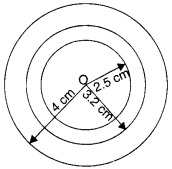
Steps of Construction
- Open the compasses for the required radius 3.2 cm, by putting the pointer on 0 and opening the pencil upto 3.2 cm.
- Draw a point with a sharp pencil and marks it as O in the centre.
- Place the pointer of the compasses where the centre has been marked.
- Turn the compasses slowly to draw the circle.
Question 2.
With the same centre O, draw two circles of radii 4 cm and 2.5 cm.
Solution :
Steps of Construction
1. For circle of radius 4 cm
- Open the compasses for the required radius 4 cm, by putting the pointer on 0 and opening the pencil upto 4 cm.
- Place the pointer of the compasses at O.
- Turn the compasses slowly to draw the circle.
2. For circle of radius 2.5 cm
- Open the compasses for the required radius 2.5 cm. by putting the pointer on 0 and opening the pencil upto 2.5 cm.
- Place the pointer of the compasses at O.
- Turn the compasses slowly to draw the circle.
Question 3.
Draw a circle and any two of its diameters. If you join the ends of these diameters, what is the figure obtained? What figure is obtained if the diameters are perpendicular to each other? How do you check your answer?
Solution :
(i) On joining the ends of any two diameters of the circle, the figure obtained is a rectangle.
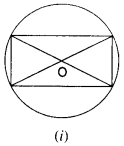
(ii) On joining the ends of any two diameters of the circle, perpendicular to each other, the figure obtained is a square.
To check the answer, we measured the sides and angles of the figure obtained.
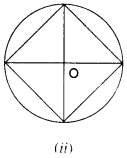
Question 4.
Draw any circle and mark points A, B and C such that:
(a) A is on the circle.
(b) B is in the interior of the circle.
(c) C is in the exterior of the circle.
Solution :
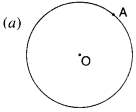
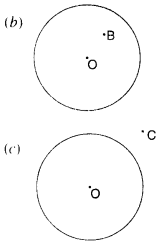
Question 5.
Let A, B be the centres of two circles of equal radii; draw them so that each one of them passes We need a ruler here. through the centre of the other. Let them intersect at C and D. Examine whether
Solution :
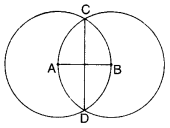
Yes!
Exercise 14.2
Question 1.
Draw a line segment of length 7.3 cm. using a ruler.
Solution :
Using ruler, we mark two points A and B which are 7.3 cm apart. Join A and B and get AB.
![]()
Question 2.
Construct a line segment of length 5.6 cm using ruler and compasses.

Solution :
Step 1. Draw a line l. Mak a point A on line l.
Step 2. Place the compasses pointer on the ∠ero mark on the ruler. Open it to place the pencil point upto the 5.6 cm mark.
Step 3. Without changing the opening of the compasses, place the pointer on A and swing an arc to cut / at B.
Step 4. AB is a line segment of required length.
Question 3.
Construct
Solution :
Steps of Construction
Step 1. Draw a line l. Mark a point A on line l.
Step 2. Place the compasses pointer on the ∠ero mark on the ruler. Open it to place the pencil point upto the 7.8 cm mark.
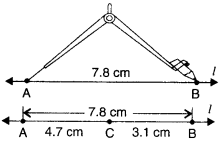
Step 3. Without changing the opening of the compasses, place the pointer on A and swing an arc to cut / at B.
Step 4.
Step 5. Place the compasses pointer on the ∠ero mark on the ruler. Open it to place the pencil point upto 4.7 cm mark.
Step 6. Without changing the opening of the compasses, place the pointer on A and swing an arc to cut / at C.
Step 7.
Question 4.
Given

(Hint : Construct
Solution :
Steps of Construction
Step 1. Draw a line I. Mark a point P on line l.
Step 2. Place the compasses pointer on the A mark of the given line segment

Step 3. Without changing the opening of the compasses, place the pointer on P and swing an arc to cut l at X.
Step 4. Again without changing the opening of the compasses place the compasses pointer on the X mark of line / and swing an arc to cut / at Q.
Step 5.
Question 5.
Given
Solution :
Steps of Construction
Step 1. Draw a line l. Mark a point X on line l.
Step 2. Place the compasses pointer on the A mark of the given line segment
Step 3. Without changing the opening of the compasses, place the pointer of compasses on X and swing an arc to cut / at ∠.
Step 4. Place the compasses pointer on the C mark of the given line segment
Step 5. Without changing the opening of the compasses, place the pointer of compasses on ∠ and swing an arc towards X to cut l at Y.
Step 6.

Please verify yourself by measurement.
Exercise 14.3
Question 1.
Draw any line segment
Solution :
Step 1. Given
Step 2. Fix the compasses pointer on P and the pencil end on Q. The opening of the instrument now
gives the length of
Step 3. Draw any line l. Choose a point A on /. Without changing the compasses setting, place the pointer on A.
Step 4. Swing an arc that cuts l at a point, say, B. Now
Question 2.
Given some line segment
Solution :
Step 1. Given
Step 2. Fix the compasses pointer on A and the pencil end on B. The opening of the instrument now gives the length of
Step 3. Draw any line l. Choose a point P on l. Without changing the compasses setting, place the pointer on P.
Step 4. Strike an arc that cuts l at a point, say, X.
Step 5. Now fix the compasses pointer on X. Strike an arc away from P that cuts l at a point, say, Q. Now, the length of
Exercise 14.4
Question 1.
Draw any line segment
Solution :
Step 1. Given a point M on any line
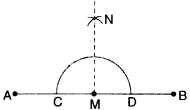
Step 2. With M as centre and a convenient radius, construct a part circle (arc) intersecting the line segment
Step 3. With C and D as centres and a radius greater than CM, construct two arcs which cut each other at N.
Step 4. Join
Question 2.
Draw any’line segment
Solution :
Step 1. Let

Step 2. Place a set-square on
Step 3. Place a ruler along the edge opposite of the right angle.
Step 4. Hold the ruler fixed. Slide the set-square along the ruler all the point R touches the arm of the set-square.
Step 5. Join RS along the edge through R, meeting
Question 3.
Draw a line l and a point X on it. Through X, draw a line segment
Solution :
Step 1. Given a point X on a line l.
Step 2. With X as centre and a convenient radius, construct a part circle (arc) intersecting the line l at two points A and B.
Step 3. With A and B as centres and a radius greater than AX, construct two arcs which cut each other at Y.
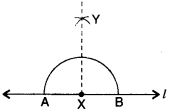
Step 4. Join
Exercise 14.5
Question 1.
Draw
Solution :
Step 1. Draw a line segment
Step 2. With A ascentere, using compasses, drawthe circle. The radius of this circle should be more than half of the length of
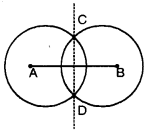
Step 3. With the same radius and with B as a centre, draw another circle using compasses. Let it cut the previous circle at C and D.
Step 4. Join CD. Then,
Question 2.
Draw a line segment of length 9.5 cm and construct its perpendicular bisector.
Solution :
Step 1. Draw a line segment
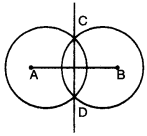
Step 2. With A as a centre, using compasses, draw a circle. The radius of this circle should be more than half of the length of
Step 3. With the same radius and with B as a centre, draw another circle using compasses. Let it cut the previous circle at C and D.
Step 4. Join CD. Then
Question 3.
Draw the perpendicular bisector of
(a) Take any point P on the bisector drawn. Examine whether PX = PY.
(b) If M is the midpoint of
Solution :
Step 1. Draw a line segment
Step 2. With X as a centre, using compasses, draw a circle. The radius of this circle should be more than half of the length of
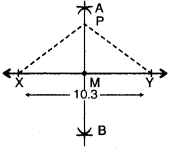
Step 3. With the same radius and with Y as a centre, draw another circle using compasses. Let it cuts the previous circle at A and B.
Step 4. Join AB. Then
(a) On examination, we find that PX = PY.
(b) We can say that the lengths of MX is half of the length of XY.
Question 4.
Draw a line segment of length 12.8 cm. Using compasses, divide it into four equal parts. Verify by actual measurement.
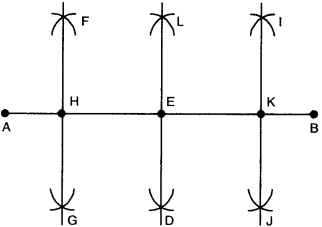
Solution :
Step 1. Draw a line segment
Step 2. With A as centre, using compasses, draw two arcs on either side of AB. The radius of this arc should be more than fialf of the length of
Step 3. With the same radius and with B as centre, draw another arcs using compasses. Let it cut the previous arcs at C and D.
Step 4. Join
Step 5. With A as centre, using compasses, draw a circle. The radius of this circle should be more than half of the length of AE.
Step 6. With the same radius and with E as centre, draw another circle using compasses; Let it cut the previous circle at F and G.
Step 7. Join
Step 8. With E as centre, using compasses, draw a circle. The radius of this circle should be more than half of the length of EB.
Step 9. With the same radius and with B as centre, draw another circle using compasses. Let it cut the previous circle at I and J.
Step 10. Join
Question 5.
With
Solution :
Step 1. Draw a line segment

Step 2. With P as centre, using compasses, draw a circle. The radius of this circle should be more than half of the length of
Step 3. With the same radius and with Q as centre, draw another circle using compasses. Let it cut the previous circle at A and B.
Step 4. Join
the perpendicular bisector of the line segment PQ .
Step 5. Place the pointer of the compasses at C and open the pencil upto P.
Step 6. Turn the compasses slowly to draw the circle.
Question 6.
Draw a circle with centre C and radius, 3.4 cm. Draw any chord
Solution :
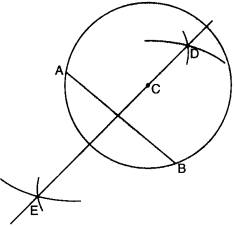
Step 1. Draw a point with a sharp pencil and mark it as C.
Step 2. Open the compasses for the required radius 3.4 cm, by putting the pointer on 0 and opening the pencil upto 3.4 cm.
Step 3. Place the pointer of the compasses at C. Step 4. Turn the compasses slowly to draw the
circle.
Step 5. Draw any chord
Step 6. With A as centre, using compasses, draw a circle. The radius of this circle should be more than half of the length of
Step 7. With the same radius and with B as centre, draw another circle using compasses. Let it cut the previous circle at D and E.
Step 8. Join
Question 7.
Repeat Question 6, if
Solution :
Step 1. Draw a point with a sharp pencil and mark it as C.
Step 2. Open the compasses for the required radius 3.4 cm, by putting the pdinter of compasses on 0 of the scale and opening the pencil upto 3.4 cm.
Step 3. Place the pointer of the compasses at C.
Step 4. Turn the compasses slowly to draw the circle.
Step 5. Draw any diameter

Step 6. With A as centre, using compasses, draw arcs on either side. The radius of this arc should be more than half of the length of
Step 7. With the same radius and with B as centre, draw another arcs using compasses. Let it cut the previous arcs at D and E.
Step 8. Join
Question 8.
Draw a circle of radius 4 cm. Draw any two of its chords. Construct the perpendicular bisectors of these chords. Where do they meet?
Solution :
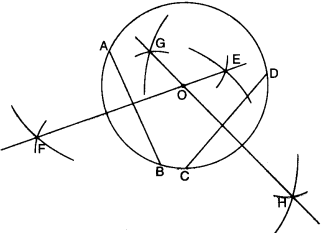
Step 1. Draw a point with a sharp pencil and mark it as O.
Step 2. Open the compasses for the required radius of 4 cm. by putting the pointer on 0 and opening the pencil upto 4 cm.
Step 3. Place the pointer of the compasses at O.
Step 4. Turn the compasses slowly to draw the circle.
Step 5. Draw any two chords
Step 6. With A as centre, using compasses, draw two arcs on either side of AB. The radius of this arc should be more than half of the length of
Step 7. With the same radius and with B as centre, draw another two arcs using compasses. Let it cut the previous circle at E and F.
Step 8. Join
Step 9. With C a< centre, using compasses, draw two arcs on either side of CD. The radius of this arc should be more than half of the length of
Step 10. With the same radius and with D as centre, draw another two arcs using compasses. Let it cut the previous circle at G and H.
Step 11. Join
Question 9.
Draw any angle with vertex O. Take a point A on one of its arms and B on another such that OA- OB. Draw the perpendicular bisectors of
Solution :
Step 1. Draw any angle POQ with vertex O.
Step 2. Take a point A on the arm OQ and another point B on the arm OP such that
Step 3. With O as centre, using compasses, draw a circle. The radius of this circle should be more than half of the length of
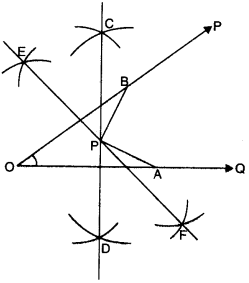
Step 4. With the same radius and with A as centre, draw another circle using compasses. Let it cut the previous circle at C and D.
Step 5. Join
Step 6. With O as centre, using compasses, draw a circle. The radius of this circle should be more than half of the length of
Step 7. With the same radius and with B as centre, draw another circle using compasses. Let it cut the previous circle at E and F.
Step 8. Join
Step 9. Join
Exercise 14.6
Question 1.
Draw ∠POQ of measure 75° and find its line of symmetry.
Solution :
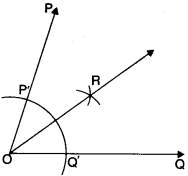
Step 1. Draw a ray
Step 2. Place the center of the protractor at O and the ∠ero edge along
Step 3. Start with 0 near Q. Mark point P at 75°
Step 4. Join
Step 5. With O as center and using compasses, draw an arc that cuts both rays of ∠POQ. Label the points of intersection as F and Q’.
Step 6. With Q’ as center, draw (in the interior of ∠POQ) an arc whose radius is more than half the length Q’F.
Step 7. With the same radius and with F as center, draw another arc in the interior of ∠POQ. Let
the two arcs intersect at R. Then,
Question 2.
Draw an angle of measure 147° and construct its bisector.
Solution :
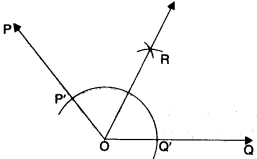
Step 1. Draw
Step 2. Place the center of the protractor at O and the ∠ero edge along
Step 3. Start with 0 near Q. Mark a point P at 147°.
Step 4. Join OP. Then, ∠POQ = 147°.
Step 5. With O as center and using compasses, draw an arc that cuts both rays of ∠POQ. Label the points of intersection as F and Q’.
Step 6. With Q’ as center, draw (in the interior of ∠POQ) an arc whose radius is more than half the length Q’F.
Step 7. With the same radius and with F as center, draw another arc in the interior of ∠POQ. Let the two arcs intersect at R. Then,
Question 3.
Draw a right angle and construct its bisector.
Solution :
Step 1. Draw a ray OQ.
Step 2. Place the center of the protractor at O and the ∠ero edge along
Step 3. Start with 0 near Q. Mark point P at 90°.
Step 4. Join
Step 5. With O as center and using compasses, draw an arc that cuts both rays of ∠POQ. Label the points of intersection as F and Q’.
Step 6. With Q’ as center, draw (in the interior of ∠POQ) an arc whose radius is more than half th length Q’F.
Step 7. With the same radius and with P center, draw another arc in the interior of ∠POQ the two arcs intersect at R. Then,
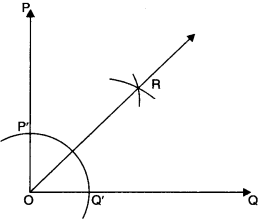
Question 4.
Draw an angle of measure 153° and divide it into four equal parts.
Solution :
Step 1. Draw a ray
Step 2. Place the center of the protractor at O and the ∠ero edge along
Step 3. Start with 0 near Q. Mark a point P at 153°.
Step 4. Join OP. Then, ∠POQ = 153°.
Step 5. With O as the center and using compasses, draw an arc that cuts both rays of ∠POQ. Label the points of intersection as F and Q.
Step 6. With Q’ as the center, draw (in the interior of ∠POQ) an arc whose radius is more than half the length Q’F.
Step 7. With the same radius and with F as a center, draw another arc in the interior of ∠POQ. Let the two arcs intersect at R. Then,
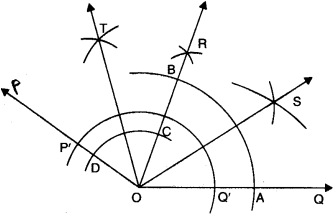
Step 8. With O as a center and using compasses, draw an arc that cuts both rays of ∠ROQ. Label the points of intersection as B and A.
Step 9. With A as a center, draw (in the interior of ∠ROQ) an arc whose radius is more than half the length AB.
Step 10. With the same radius and with B as a center, draw another arc in the interior of ∠ROQ. Let the two arcs intersect at S. Then,
Step 11. With O as a center and using compasses, draw an arc that cuts both rays of ∠POR. Label the points of intersection as D and C.
Step 12. With C as a center, draw (in the interior of ∠POR) an arc whose radius is more than half the length CD.
Step 13. With the same radius and with D as centre, draw another arc in the interior of ∠POR. Let the two arcs intersect at T. Then,
Question 5.
Construct with ruler and compasses, angles of following measures:
(a) 60°
(b) 30°
(c) 90°
(d) 120°
(e) 45°
(f) 135°.
Solution :
(a) Construction of an angle of measure 60°
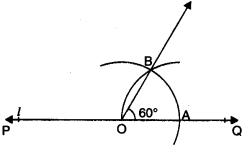
Step 1. Draw a line PQ and mark a point O on it.
Step 2. Place the pointer of the compasses at O and draw an arc of convenient radius which cuts the line PQ at a point say A.
Step 3. With the pointer at A (as center), now draw an arc that passes through O.
Step 4. Let the two arcs intersect at B. Join OB. We get ∠BOA whose measure is 60°.
(b) Construction of an angle of measure 30°
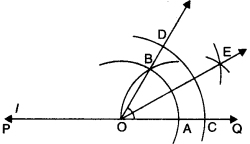
Step 1. Draw a line PQ and mark a point O on it.
Step 2. Place the pointer of the compasses at O and draw an arc of convenient radius which cuts the line PQ at a point say A.
Step 3. With the pointer at A (as center), now draw an arc that passes through O.
Step 4. Let the two arcs intersect at B. Join OB. We get ∠BOA whose measure is 60°.
Step 5. With O as a center and using compasses, draw an arc that cuts both rays of ∠BOA. Label the points of intersection as D and C.
Step 6. With C as a center, draw (in the interior of ∠BOA) an arc whose radius is more than half the length CD.
Step 7. With the same radius and with D as a center, draw another arc in the interior of ∠BOA. Let the two arcs intersect at E. Then,
(c) Construction of an angle of measure 90°
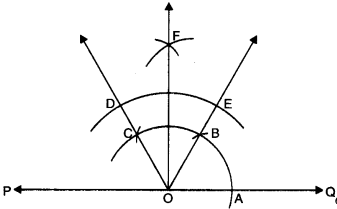
Step 1. Draw any line PQ and take a point O on it.
Step 2. Place the pointer of the compasses at O and draw an arc of convenient radius which cuts the line at A.
Step 3. Without disturbing the radius on the compasses, draw an arc with A as a center which cuts the first arc at B.
Step 4. Again without disturbing the radius on the compasses and with B as a center, draw an arc which cuts the first arc at C.
Step 5. Join OB and OC.
Step 6. With O as a center and using compasses, draw an arc that cuts both rays of ∠COB. Label the points of intersection as D and E.
Step 7. With E as a center, draw (in the interior of ∠COB) an arc where the radius is more than half the length ED.
Step 8. With the same radius and with D as a center, draw another arc in the interior of ∠COL. Let
the two arcs intersect at F. Join
(d) Construction of an angle of measure 120°

Step 1. Draw any line PQ and take a point O on it.
Step 2. Place the pointer of the compass es at O and draw an arc of convenient radius which puts the line at A. • ‘
Step 3. Without disturbing the radius on the compasses, draw an arc with A as a center which cuts the first arc at B.
Step 4. Again without disturbing the i alius > on the compasses and with B as a center, draw an arc which cuts the first arc at C. .
Step 5. Join OC. Then, ∠COA is the required angle whose measure is 120°.
(e) Construction of an angle of measure 45°
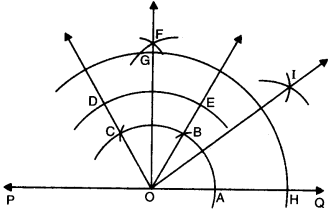
Step 1. Draw any line PQ and take a point O on it.
Step 2. Place the pointer of the compasses at O and draw an arc of convenient radius which cuts the line at A.
Step 3. Without disturbing the radius on the compasses, draw an arc with A as a center which cuts the first arc at B.
Step 4. Again without disturbing the radius on the compasses and with B as a center, draw an arc which cuts the first arc at C.
Step 5. Join OB and OC.
Step 6. With O as a center and using compasses, draw an arc that cuts both rays of ∠COB. Label the points of intersection as D and E.
Step 7. With E as a center, draw (in the interior of ∠COB) an arc whose radius is more than half the length ED.
Step 8. With the same radius and with D as a center, draw another arc in the interior of ∠COB. Let the two arcs intersect at F. Join OF. Then, ∠FOQ = 90°.
Step 9. With O as a center and using compasses, draw an arc that cuts both rays to ∠FOQ. Label the points of the intersection as G and H.
Step 10. With H as a center, draw (in the interior of. ∠FOQ) an arc whose radius is more than half the length HG.
Step 11. With the same radius and with G as a center, draw another arc in the interior of ∠FOQ. Let the two arcs intersect at I. Join OI. Then, OI is the bisector of ∠FOH, i.e., ∠FOI = ∠IOH. Now,
∠FOI = ∠IOH = 45°.
(f) Construction of an angle of measure 135° it.
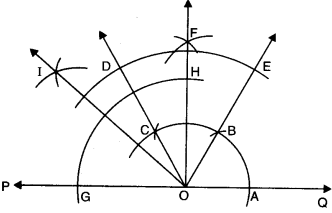
Step 1. Draw any line PQ and take a point O on it.
Step 2. Place the pointer of the compasses at O and draw an arc of convenient radius which cuts the line at A.
Step 3. Without disturbing the radius on the compasses, draw an arc with A as a center which cuts the first arc at B.
Step 4. Again without disturbing the radius on the compasses and with B as a center, draw an arc which cuts the first arc at C.
Step 5. Join OB and OC.
Step 6. With O as a center and using compasses, draw an arc that cuts both rays of ∠COB. Label the points of intersection as D and E.
Step 7. With E as the center, draw (in the interior of ∠COB) an arc whose radius is more than half the length ED.
Step 8. With the same radius and with D as the center, draw another arc in the interior of ∠COB. Let the two arcs intersect at F. Join
Step 9. With O as a center and using compasses, draw an arc that cuts both rays of ∠POF. Label the points of intersection as G and H.
Step 10. With H as center draw (in the interior of ∠POF) an arc whose radius is more than half the length HG.
Step 11. With the same radius and with G as a center, draw another arc in the interior of ∠POF. Let
the two arcs intersect at I. Join 01. Then,
Question 6.
Draw an angle of measure 45° and bisect it.
Solution :

Step 1. Draw any line PQ and take a point O on it.
Step 2. Place the pointer of the compasses at O and draw an arc of convenient radius which cuts the line at A. ’
Step 3. Without disturbing the radius on the compasses, draw an arc with A as a center which cuts the first arc at B.
Step 4. Again without disturbing the radius on the compasses and with B as a center, draw an arc which cuts the first arc at C.
Step 5. Join OB and OC.
Step 6. With O as a center and using compasses, draw an arc that cuts both rays of ∠COB. Label the points of intersection as D and E.
Step 7. With E as a center, draw (in the interior of ∠COB) an arc whose radius is more than half the length ED.
Step 8. With the same radius and with D as a center, draw another arc in the interior of ∠COB. Let
the two arcs intersect at F. Join OF. Then ∠FOQ = 90°.
Step 9. With O as a center and using compasses, draw an arc that cuts both rays of ∠FOQ. Label the points of intersection on G and H.
Step 10. With G as a center, draw in the interior of ∠FOQ) an arc whose radius is more than half the length HG.
Step 11. With the same radius and with G as a center, draw another arc in the interior of ∠FOQ. Let the two arcs intersect at I. Join OI. Then OI is the bisector of ∠FOQ, i.e., ∠FOI = ∠IOH. Now, ∠FOI = ∠IOH = 45°.
Step 12. With O as a center and using compasses, draw an arc that cuts both rays of ∠IOH. Label the points of intersection as J and K.
Step 13. With K as a center, draw (in the interior of ∠IOH) an arc whose radius is more than half the length KJ.
Step 14. With the same radius and with J as a center, draw another arc in the interior of ∠IOH. Let the two arcs intersect at L. Join OL. Then OL is the bisector of ∠IOH, i.e., ∠IOL = ∠LOK
Question 7.
Draw an angle of measure 135° and bisect it.
Solution :
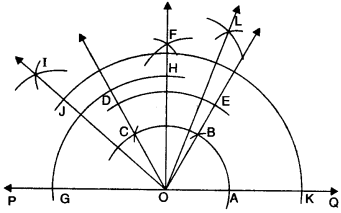
Step 1. Draw any line PQ and take a point O on.
Step 2. Place the pointer of the compasses at’ and draw an arc of convenient radius which cul line at A.
Step 3. Without disturbing the radius on the compasses, draw an arc with A as a center which cuts the first arc at B.
Step 4. Again without disturbing the radius on the compasses and with B as a center, draw an arc which cuts the first arc at C.
Step 5. Join OB and OC.
Step 6. With O as a center and using compasses, draw an arc that cuts both rays of ∠COB. Label the points of intersection as D and E.
Step 7. With E as a center, draw (in the interior of ∠COB) an arc whose radius is more than half the length ED.
Step 8. With the same radius and with D as a center, draw another arc in the interior of ∠COB. Let
the two arcs intersect at F. Join
Step 9. With O as a center and using compasses, draw an arc that cuts both rays of ∠POF. Label the points of intersection as G and H.
Step 10. With G as a center, draw in the interior of ∠POF an arc whose radius is more than half the length HG.
Step 11. With the same radius and with H as a centre, draw another arc in the interior of ∠POF. Let
the two arcs intersect at I. Join
Step 12. With O as centre and using compasses, draw an arc that cuts both rays of ∠IOQ. Label the points of intersection as J and K.
Step 13. With K as centre, draw (in the interior of ∠IOQ) an arc whose radius is more than half the length KJ.
Step 14. With the same radius and with J as centre, draw another arc in the interior of ∠IOQ. Let the two arcs intersect at L. Join
Question 8.
Draw an angle of 70°. Make a copy of it using only a straight edge and compasses.
Solution :
Steps of construction
1. Construct an angle ABC = 70°.
2. Take a line z and mark a point D on it.
3. Fix the compasses pointer on B and draw an arc which cuts the sides of ∠ABC at D and E.
4. Without changing the compasses setting, place the pointer on P and draw an arc which cuts ∠ at Q.
5. Open the compasses equal to length DE.
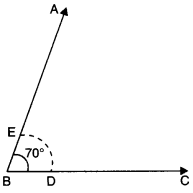
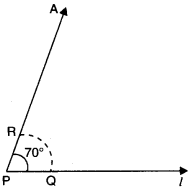
6. Without disturbing the radius on compasses, place its pointer at Q and draw an arc which cuts the previous arc at R.
7. Join PR and draw ray PR. It gives ∠RPQ which is the required angle whose measure is equal to the measure of ∠ABC.
Question 9.
Draw an angle of 40°. Copy its supplementary angle.
Solution :
Steps of construction


1. Draw ∠CAB = 40°.
2. Draw a line I and mark a point P on it.
3. Place the pointer of the compasses on A and draw an arc which cuts extended BA at E and AC at F.
4. Without changing the radius on compasses, place its pointer at P and draw an arc which cuts l at Q.
5. Open the length of compasses equal to EF.
6. Without disturbing the radius on compasses, place its pointer at Q and draw an arc which cuts the previous arc at R.
7. Join QR and draw ray QR. It gives ∠RQS which is the required angle whose measure